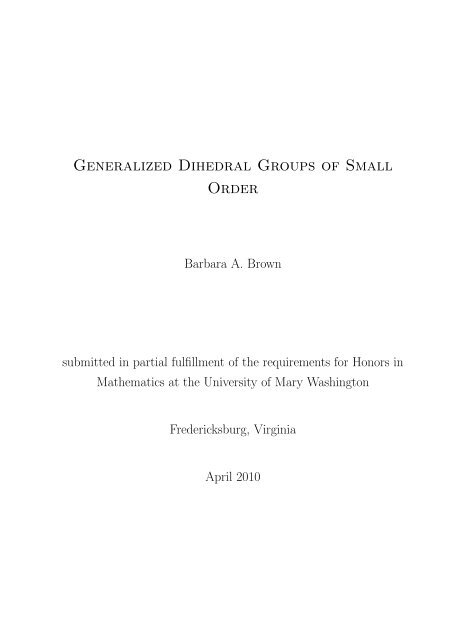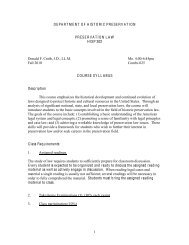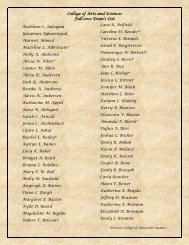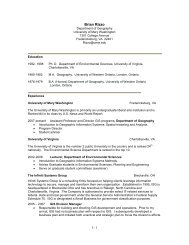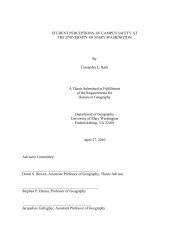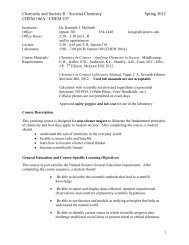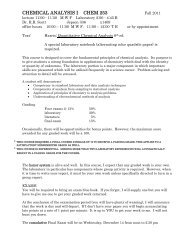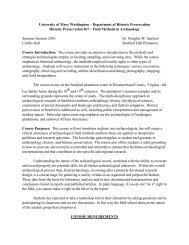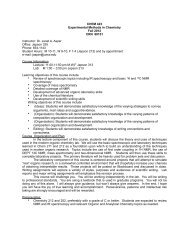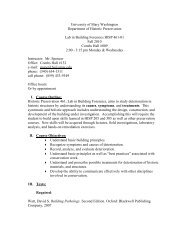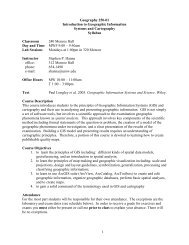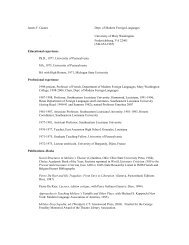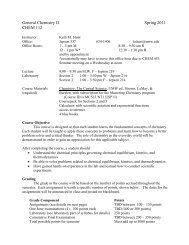Generalized Dihedral Groups - of Dr. Randall D. Helmstutler
Generalized Dihedral Groups - of Dr. Randall D. Helmstutler
Generalized Dihedral Groups - of Dr. Randall D. Helmstutler
- No tags were found...
You also want an ePaper? Increase the reach of your titles
YUMPU automatically turns print PDFs into web optimized ePapers that Google loves.
<strong>Generalized</strong> <strong>Dihedral</strong> <strong>Groups</strong> <strong>of</strong> Small<br />
Order<br />
Barbara A. Brown<br />
submitted in partial fulfillment <strong>of</strong> the requirements for Honors in<br />
Mathematics at the University <strong>of</strong> Mary Washington<br />
Fredericksburg, Virginia<br />
April 2010
This thesis by Barbara A. Brown is accepted in its present form as satisfying the thesis<br />
requirement for Honors in Mathematics.<br />
Date<br />
Approved<br />
<strong>Randall</strong> D. <strong>Helmstutler</strong>, Ph.D.<br />
thesis advisor<br />
Janusz Konieczny, Ph.D.<br />
committee member<br />
Keith E. Mellinger, Ph.D.<br />
committee member
Contents<br />
1 Introduction 1<br />
2 The Classical <strong>Dihedral</strong> <strong>Groups</strong> 1<br />
2.1 The <strong>Dihedral</strong> Group D 4 . . . . . . . . . . . . . . . . . . . . . . . . . . . . . 2<br />
2.2 Structure <strong>of</strong> D 4 . . . . . . . . . . . . . . . . . . . . . . . . . . . . . . . . . . 3<br />
3 Semi-direct Products and <strong>Generalized</strong> <strong>Dihedral</strong> <strong>Groups</strong> 4<br />
3.1 Semi-direct Products . . . . . . . . . . . . . . . . . . . . . . . . . . . . . . . 4<br />
3.2 <strong>Generalized</strong> <strong>Dihedral</strong> <strong>Groups</strong> . . . . . . . . . . . . . . . . . . . . . . . . . . . 6<br />
4 Main Results 7<br />
4.1 The Group Operation and Subgroups . . . . . . . . . . . . . . . . . . . . . . 7<br />
4.2 Elements <strong>of</strong> Order Two . . . . . . . . . . . . . . . . . . . . . . . . . . . . . . 8<br />
4.3 Centers . . . . . . . . . . . . . . . . . . . . . . . . . . . . . . . . . . . . . . 10<br />
4.4 The Isomorphism Problem . . . . . . . . . . . . . . . . . . . . . . . . . . . . 12<br />
5 Calculations <strong>of</strong> <strong>Generalized</strong> <strong>Dihedral</strong> <strong>Groups</strong> 14<br />
5.1 <strong>Dihedral</strong>izing Z 2 × Z 4 . . . . . . . . . . . . . . . . . . . . . . . . . . . . . . . 14<br />
5.2 <strong>Dihedral</strong>izing Z 3 × Z 3 . . . . . . . . . . . . . . . . . . . . . . . . . . . . . . . 16<br />
5.3 Matrix Representation <strong>of</strong> D(Z 3 × Z 3 ) . . . . . . . . . . . . . . . . . . . . . . 17<br />
5.4 <strong>Dihedral</strong>ization <strong>of</strong> C 2 × G . . . . . . . . . . . . . . . . . . . . . . . . . . . . 18<br />
6 Sylow Structure <strong>of</strong> <strong>Generalized</strong> <strong>Dihedral</strong> <strong>Groups</strong> 20<br />
6.1 Sylow Theorems . . . . . . . . . . . . . . . . . . . . . . . . . . . . . . . . . . 20<br />
6.2 Sylow Subgroups <strong>of</strong> <strong>Generalized</strong> <strong>Dihedral</strong> <strong>Groups</strong> . . . . . . . . . . . . . . . 21<br />
A Table A: Non-abelian <strong>Groups</strong> <strong>of</strong> Order 16 23<br />
B Table B: Non-abelian <strong>Groups</strong> <strong>of</strong> Order 18 24<br />
C Table C: <strong>Generalized</strong> <strong>Dihedral</strong> <strong>Groups</strong> <strong>of</strong> Order ≤ 48 25<br />
References 26
Abstract<br />
Given any abelian group G, the generalized dihedral group <strong>of</strong> G is the semi-direct<br />
product <strong>of</strong> C 2 = {±1} and G, denoted D(G) = C 2 ⋉ ϕ G. The homomorphism ϕ maps<br />
C 2 to the automorphism group <strong>of</strong> G, providing an action on G by inverting elements.<br />
The groups D(G) generalize the classical dihedral groups, as evidenced by the isomorphism<br />
between D(Z n ) and D n . We will characterize the abelian generalized dihedral<br />
groups and supply structural information regarding centers and Sylow subgroups. We<br />
attempt to identify the groups D(G) up to isomorphism as we dihedralize each abelian<br />
group G <strong>of</strong> order 1 to 24. The results appear in the table in Appendix C.<br />
1 Introduction<br />
Nearly every grade school student, when working with a construction paper square in art<br />
class or playing Four Square at recess, has observed the symmetries <strong>of</strong> a square. What the<br />
young students did not realize was that the exploration <strong>of</strong> symmetries <strong>of</strong> polygons leads to<br />
the dihedral groups, which are essential to studies in group theory, geometry and chemistry.<br />
The classical dihedral groups have been thoroughly studied by mathematicians for some<br />
time, and because <strong>of</strong> their structure it is not unusual for these groups to be explored in an<br />
undergraduate-level course. Initially, our mission will be to determine the correct generalization<br />
<strong>of</strong> the dihedral groups. Once the correct generalization is established, our goal will<br />
be to compile a “dictionary” <strong>of</strong> generalized dihedral groups <strong>of</strong> small order. The purpose <strong>of</strong><br />
compiling the dictionary will be to make conjectures about the structure <strong>of</strong> D(G) based on<br />
that <strong>of</strong> G. The first step in completing the dictionary will be to create a list <strong>of</strong> all abelian<br />
groups up to order 24. We will then attempt to compute the generalized dihedral group<br />
D(G) for each abelian group G in our list. We will see that the computation <strong>of</strong> some groups<br />
will require more work than others; we will provide some sample calculations here. Finally,<br />
we will study the Sylow structure <strong>of</strong> D(G) to see how it relates to the Sylow structure <strong>of</strong><br />
the associated abelian group G. We begin our exploration with a discussion <strong>of</strong> the classical<br />
dihedral groups.<br />
2 The Classical <strong>Dihedral</strong> <strong>Groups</strong><br />
We define the dihedral groups as the groups <strong>of</strong> geometric symmetries <strong>of</strong> regular polygons.<br />
These symmetries are found in both the rotations and the reflections <strong>of</strong> the figure. Generally<br />
speaking, a regular polygon with n sides has 2n different symmetries which include<br />
1
n rotational symmetries and n reflective symmetries. With the operation <strong>of</strong> composition,<br />
these symmetries form the dihedral group D n , where the subscript n indicates the number<br />
<strong>of</strong> sides <strong>of</strong> the polygon.<br />
2.1 The <strong>Dihedral</strong> Group D 4<br />
As an example, we will focus on the group <strong>of</strong> symmetries <strong>of</strong> the square, which is the dihedral<br />
group D 4 . It should be mentioned here that some mathematicians denote the group <strong>of</strong><br />
symmetries <strong>of</strong> the square by D 8 , where the subscript indicates the number <strong>of</strong> symmetries <strong>of</strong><br />
the square. We, <strong>of</strong> course, will use the notation D 4 .<br />
Rotating the square gives rise to four symmetries. We will label them as follows:<br />
1 = identity rotation (no motion)<br />
R 90 = rotation 90 ◦ counterclockwise<br />
R 180 = rotation 180 ◦ counterclockwise<br />
R 270 = rotation 270 ◦ counterclockwise.<br />
Additionally, the reflections across the diagonal, vertical, and horizontal lines <strong>of</strong> symmetry<br />
give rise to four more symmetries. We will denote these as follows:<br />
S v = reflection through the vertical line<br />
S h = reflection through the horizontal line<br />
S d1 = reflection through the diagonal running northwest to southeast<br />
S d2 = reflection through the diagonal running northeast to southwest.<br />
We gain a more complete understanding <strong>of</strong> the group D 4 when we start to combine one<br />
motion with another motion. For example, we may combine a rotation <strong>of</strong> 90 ◦ with a rotation<br />
<strong>of</strong> 180 ◦ . The result is a rotation by 270 ◦ , which we write as R 180 ◦ R 90 = R 270 . Likewise, we<br />
might follow a rotation by 180 ◦ with a reflection through the vertical line <strong>of</strong> symmetry. This<br />
composition would be no different than simply performing a reflection through the horizontal<br />
line <strong>of</strong> symmetry, and we can express this as S v ◦ R 180 = S h .<br />
Since inverse elements play an important role in algebra, it is interesting to think about<br />
which motions behave as inverses <strong>of</strong> other motions. For example, a reflection through the<br />
diagonal line running northwest to southeast followed by a reflection through that same<br />
diagonal line brings us to the original position, that is, the identity rotation. In fact, each<br />
reflection behaves this way: each reflective motion is its own inverse. In other words, the<br />
four reflections in this group are each <strong>of</strong> order two. Notice that while the same can be said<br />
for the rotation by 180 ◦ , it is the only rotation <strong>of</strong> order two.<br />
2
2.2 Structure <strong>of</strong> D 4<br />
To better understand the generalization <strong>of</strong> these classical dihedral groups we will look at the<br />
structure <strong>of</strong> the specific dihedral group D 4 . The Cayley table for D 4 is given below.<br />
◦ 1 R 90 R 180 R 270 S v S h S d1 S d2<br />
1 1 R 90 R 180 R 270 S v S h S d1 S d2<br />
R 90 R 90 R 180 R 270 1 S d1 S d2 S h S v<br />
R 180 R 180 R 270 1 R 90 S h S v S d2 S d1<br />
R 270 R 270 1 R 90 R 180 S d2 S d1 S v S h<br />
S v S v S d2 S h S d1 1 R 180 R 270 R 90<br />
S h S h S d1 S v S d2 R 180 1 R 90 R 270<br />
S d1 S d1 S v S d2 S h R 90 R 270 1 R 180<br />
S d2 S d2 S h S d1 S v R 270 R 90 R 180 1<br />
Note that D 4 is non-abelian; for instance the elements S h and S d1 do not commute. Next<br />
we may observe the partitioning <strong>of</strong> the table. Each <strong>of</strong> the four “quadrants” is exclusively<br />
rotations or reflections. It turns out that the rotations form a cyclic subgroup generated by<br />
the smallest rotation, R 90 . What’s more, the subgroup <strong>of</strong> rotations is normal in D 4 as it is<br />
<strong>of</strong> index two.<br />
Take the reflection S v in D 4 , and let H be the subgroup formed by the identity and this<br />
reflection, so H = {1, S v }. A check <strong>of</strong> this reflective subgroup reveals that H is not normal:<br />
H is not closed under conjugation since R 90 ◦ S v ◦ R90 −1 = S h . Notice here that R90 −1 = R 270 .<br />
What is truly remarkable is that we can produce every element <strong>of</strong> D 4 simply by hitting each<br />
element <strong>of</strong> H against each element <strong>of</strong> R, where R is the subgroup <strong>of</strong> rotations. That is,<br />
composing 1 with each element <strong>of</strong> R will produce all <strong>of</strong> the rotations, and composing the<br />
single reflection S v with each element <strong>of</strong> R will produce all <strong>of</strong> the reflections. For example,<br />
we can obtain the reflection S d2 in this way by noting the composition S v ◦ R 90 = S d2 . Thus<br />
the dihedral group D 4 can be expressed as<br />
D 4 = HR<br />
where the juxtaposition <strong>of</strong> these subgroups simply means to take all products <strong>of</strong> elements<br />
between them. Additionally, we observe that H and R intersect trivially, that is<br />
H ∩ R = {1}.<br />
Lastly, we remark on the relation between conjugates and inverses. One can check that<br />
if we conjugate a rotation by a reflection, we are returned the inverse <strong>of</strong> that rotation. For<br />
example, we have S v ◦ R 90 ◦ Sv<br />
−1 = S v ◦ R 90 ◦ S v = R 270 . Notice here that R 270 is in fact the<br />
inverse <strong>of</strong> R 90 . We say that conjugation acts by inversion on the subgroup R <strong>of</strong> rotations.<br />
3
3 Semi-direct Products and <strong>Generalized</strong> <strong>Dihedral</strong> <strong>Groups</strong><br />
3.1 Semi-direct Products<br />
We are nearly ready to generalize the classical dihedral groups, but in order to do so we<br />
must discuss the role <strong>of</strong> automorphisms in semi-direct products.<br />
Definition 3.1. An automorphism <strong>of</strong> a group G is an isomorphism ϕ : G → G. The set <strong>of</strong><br />
all such automorphisms is denoted Aut(G).<br />
One can check that Aut(G) forms a group under composition, known as the automorphism<br />
group <strong>of</strong> G.<br />
Let’s consider, for example, a group G on which we define a function i : G → G by<br />
i(g) = g −1 , where i here stands for inversion. We will prove in the following proposition<br />
that it is the abelian quality <strong>of</strong> G that makes inversion a homomorphism and ultimately an<br />
automorphism.<br />
Proposition 3.2. Let G be a group and define i : G → G by i(g) = g −1 . The function i is<br />
an automorphism if and only if G is abelian.<br />
Pro<strong>of</strong>. First we will show that i is bijective. Take g ∈ G and apply i ◦ i:<br />
(i ◦ i)(g) = i(i(g)) = i(g −1 ) = (g −1 ) −1 = g.<br />
Thus we see that i ◦ i = 1 G , so i is a bijection.<br />
Next we will prove that i is a homomorphism if and only if G is abelian. First assume<br />
that G is abelian, and take any a, b ∈ G. Computing the inverse <strong>of</strong> the product <strong>of</strong> these two<br />
elements we get<br />
i(ab) = (ab) −1 = b −1 a −1 = a −1 b −1 = i(a)i(b).<br />
Hence i is a homomorphism.<br />
Now we will assume that i is a homomorphism. Note that<br />
i(ab) = i(a)i(b) = a −1 b −1 = (ba) −1 = i(ba).<br />
We now have i(ab) = i(ba), and applying i to both sides <strong>of</strong> this equation gives ab = ba.<br />
Hence G is abelian.<br />
We see now that if G is abelian, then i belongs to Aut(G), the automorphism group <strong>of</strong> G.<br />
Later we find that this special homomorphism produces the multiplication in the semi-direct<br />
product which will generalize the dihedral groups.<br />
Many groups such as R 2 and the Klein four-group are direct products <strong>of</strong> other groups.<br />
We might think <strong>of</strong> a group like R 2 as being constructed from two copies <strong>of</strong> R in a cross<br />
4
product (the external version) or as the decomposition into the x-axis and y-axis (the internal<br />
version). In either case, we have a direct product concerning two subgroups, each <strong>of</strong> which is<br />
normal in the parent group. Many groups cannot be distilled into a direct product, however<br />
some may be decomposed into a semi-direct product. A semi-direct product has both internal<br />
and external versions as well, but only one <strong>of</strong> the factors is normal in the semi-direct product.<br />
In essence, the normality <strong>of</strong> one factor in the direct product is replaced in the semi-direct<br />
product with an action on the automorphism group <strong>of</strong> the other (the normal one). The<br />
homomorphism which acts on the normal factor in the semi-direct product gives rise to a<br />
group operation.<br />
Definition 3.3. Suppose that G is a group with subgroups H and N. The group G is the<br />
internal semi-direct product <strong>of</strong> H with N, written G = H ⋉ N, if<br />
1. G = HN,<br />
2. H ∩ N = {e}, and<br />
3. N is normal in G.<br />
There is a canonical homomorphism ϕ : H → Aut(N) given by conjugation by elements<br />
<strong>of</strong> H. We will write ϕ h ∈ Aut(N) instead <strong>of</strong> ϕ(h) ∈ Aut(N). So, for h ∈ H and n ∈ N,<br />
we have ϕ h (n) = hnh −1 . This action determines the operation <strong>of</strong> G on its elements hn as<br />
follows:<br />
(h 1 n 1 )(h 2 n 2 ) = (h 1 h 2 )(h −1<br />
2 n 1 h 2 n 2 )<br />
= (h 1 h 2 )(ϕ h<br />
−1<br />
2 (n 1)n 2 ).<br />
As we have already suggested, there is an external version <strong>of</strong> the semi-direct product. It<br />
is described in the definition that follows.<br />
Definition 3.4. Suppose H and N are groups. Let ϕ : H → Aut(N) be a homomorphism.<br />
The external semi-direct product <strong>of</strong> H with N under ϕ, denoted H ⋉ ϕ N, is the group <strong>of</strong><br />
ordered pairs (h, n) (where h ∈ H and n ∈ N) under the operation<br />
(h 1 , n 1 )(h 2 , n 2 ) = (h 1 h 2 , ϕ h<br />
−1<br />
2 (n 1)n 2 ).<br />
It turns out that the internal and external versions <strong>of</strong> the semi-direct product are equivalent,<br />
but before we prove this we need to address the uniqueness <strong>of</strong> representation <strong>of</strong> elements<br />
in an internal semi-direct product.<br />
Lemma 3.5. Assume that G = H ⋉ N. Then each g ∈ G is uniquely expressible as g = hn<br />
for h ∈ H and n ∈ N.<br />
5
Pro<strong>of</strong>. We want to show that if h 1 n 1 = h 2 n 2 then h 1 = h 2 and n 1 = n 2 , where h 1 , h 2 ∈ H<br />
and n 1 , n 2 ∈ N. Supposing h 1 n 1 = h 2 n 2 we have<br />
h 1 n 1 = h 2 n 2<br />
h −1<br />
1 h 1 n 1 = h −1<br />
1 h 2 n 2<br />
n 1 n −1<br />
2 = h −1<br />
1 h 2 n 2 n −1<br />
2<br />
n 1 n −1<br />
2 = h −1<br />
1 h 2 .<br />
This result indicates that an element in N is equal to an element in H. Since G = H ⋉ N,<br />
we know that H ∩N = {e}. Therefore, we can conclude that n 1 n −1<br />
2 = h −1<br />
1 h 2 = e. We readily<br />
find that n 1 = n 2 and h 1 = h 2 .<br />
Theorem 3.6. The internal semi-direct product G = H ⋉ N is isomorphic to the external<br />
version H ⋉ ϕ N, where the homomorphism ϕ : H → Aut(N) is defined by conjugation.<br />
Pro<strong>of</strong>. Define λ : H ⋉ N → H ⋉ ϕ N by λ(hn) = (h, n) for h ∈ H, n ∈ N. Take elements<br />
h 1 , h 2 ∈ H and n 1 , n 2 ∈ N. Now λ is a homomorphism, as seen in the following:<br />
λ((h 1 n 1 )(h 2 n 2 )) = λ((h 1 h 2 )(ϕ h<br />
−1<br />
2 (n 1)n 2 ))<br />
Next we need to show that λ is invertible.<br />
= (h 1 h 2 , ϕ h<br />
−1<br />
2 (n 1)n 2 )<br />
= (h 1 , n 1 )(h 2 , n 2 )<br />
= λ(h 1 n 1 )λ(h 2 n 2 ).<br />
κ(h, n) = hn for h ∈ H, n ∈ N. Apply κ ◦ λ to hn and get<br />
Similarly we compute the following:<br />
(κ ◦ λ)(hn) = κ(h, n) = hn.<br />
(λ ◦ κ)(h, n) = λ(hn) = (h, n).<br />
Let’s define κ : H ⋉ ϕ N → H ⋉ N by<br />
Hence we have shown that κ ◦ λ = 1 G and λ ◦ κ = 1 H⋉ϕN. Therefore λ is an isomorphism<br />
between H ⋉ N and H ⋉ ϕ N.<br />
3.2 <strong>Generalized</strong> <strong>Dihedral</strong> <strong>Groups</strong><br />
The classical dihedral groups are well-known to mathematicians. The specific case <strong>of</strong> D 4<br />
considered in Section 2.1 is representative <strong>of</strong> the classical dihedral groups. As we noted in<br />
Section 2.2, the group D 4 with its subgroup <strong>of</strong> rotations R and subgroup H containing a<br />
6
single reflection can be written as D 4 = HR. The cyclic subgroup R is normal in D 4 , and<br />
the subgroups H and R intersect trivially. The group D 4 meets the definition <strong>of</strong> semi-direct<br />
product and can be expressed as H ⋉ R. By Theorem 3.6, we know that H ⋉ R ∼ = H ⋉ ϕ R<br />
where the homomorphism ϕ is defined by conjugation. Additionally, in D 4 , conjugation<br />
<strong>of</strong> a rotation by the single reflection in H results in the inverse <strong>of</strong> that rotation. Thus H<br />
acts on R by inversion. One can check that the two-element group H is isomorphic to the<br />
multiplicative group C 2 = {±1}. Now the homomorphism ϕ maps C 2 to the automorphism<br />
group <strong>of</strong> R where ϕ 1 (g) = g and ϕ −1 (g) = g −1 for any g ∈ R. This structure leads us<br />
directly to the generalization <strong>of</strong> the dihedral groups. The group <strong>of</strong> rotations generalizes to<br />
any abelian group G and the reflection group H is represented by the group C 2 . We can<br />
succinctly define the generalized dihedral group D(G) below.<br />
Definition 3.7. Let G be an abelian group. Define an action ϕ : C 2 → Aut(G) by<br />
ϕ 1 (g) = g<br />
ϕ −1 (g) = g −1<br />
for each g ∈ G. The generalized dihedral group <strong>of</strong> G is defined as D(G) = C 2 ⋉ ϕ G.<br />
Since the subgroup C 2 contains only the elements ±1, we can simplify the following:<br />
⎧<br />
⎨g, h = 1<br />
ϕ h (g) =<br />
⎩g −1 , h = −1.<br />
For any h being ±1 and any g ∈ G we can conclude that ϕ h (g) = g h .<br />
4 Main Results<br />
4.1 The Group Operation and Subgroups<br />
It will be helpful to simplify the multiplication that is part <strong>of</strong> the structure <strong>of</strong> the generalized<br />
dihedral groups. Since we are working with a semi-direct product we multiply according to<br />
the laws described in Section 3.1. For (c 1 , g 1 ), (c 2 , g 2 ) ∈ D(G) we have by definition<br />
(c 1 , g 1 )(c 2 , g 2 ) = (c 1 c 2 , ϕ c<br />
−1<br />
2 (g 1)g 2 )<br />
= (c 1 c 2 , ϕ c2 (g 1 )g 2 )<br />
= (c 1 c 2 , g c 2<br />
1 g 2 ).<br />
Note in the above that we used c 2 = c −1<br />
2 for c 2 = ±1. Recognizing this simplified product<br />
will be useful in much <strong>of</strong> the work that follows.<br />
The following proposition states that dihedralization preserves subgroups.<br />
7
Proposition 4.1. If H is a subgroup <strong>of</strong> an abelian group G then D(H) is a subgroup <strong>of</strong><br />
D(G).<br />
Pro<strong>of</strong>. We will use the subgroup test. First, D(H) is not empty as (1, e) ∈ D(H). To show<br />
closure under multiplication, take (c 1 , h 1 ), (c 2 , h 2 ) ∈ D(H). Forming the product, we get<br />
(c 1 , h 1 )(c 2 , h 2 ) = (c 1 c 2 , h c 2<br />
1 h 2 )<br />
which lives in D(H). Finally, we claim that inverses exist in D(H). Moreover we assert that<br />
(c, h) −1 = (c, h −c ). To see this, note that<br />
(c, h)(c, h −c ) = (c 2 , h c h −c ) = (1, e)<br />
and similarly (c, h −c )(c, h) produces the identity. Thus D(H) is a subgroup <strong>of</strong> D(G).<br />
The next proposition asserts that if H is a subgroup <strong>of</strong> G then it also appears as a<br />
subgroup <strong>of</strong> D(G).<br />
Proposition 4.2. If H is a subgroup <strong>of</strong> the abelian group G, then H ∼ = {1}×H is a subgroup<br />
<strong>of</strong> D(G).<br />
Pro<strong>of</strong>. We will use the subgroup test. We first note that {1}×H is not empty for it contains<br />
(1, e). Given (1, h 1 ), (1, h 2 ) ∈ {1} × H we get<br />
(1, h 1 )(1, h 2 ) = (1, h 1 h 2 ).<br />
Thus {1} × H is closed under multiplication. Given (1, h) ∈ {1} × H we have (1, h) −1 =<br />
(1, h −1 ) which shows closure under taking inverses. Thus {1}×H is a subgroup <strong>of</strong> D(G).<br />
4.2 Elements <strong>of</strong> Order Two<br />
Elements <strong>of</strong> order two are intriguing if for no other reason than they are their own inverses.<br />
Their quantity alone is noteworthy in the classical dihedral groups: as we have already seen,<br />
every reflection in D 4 is <strong>of</strong> order two. We will make some observations here about elements<br />
that square to the identity. Of particular relevance is the subgroup <strong>of</strong> these elements.<br />
Definition 4.3. Let G be an abelian group. The set G 2 is comprised <strong>of</strong> all elements <strong>of</strong> G<br />
which square to the identity, namely G 2 = {g ∈ G | g 2 = e}.<br />
It is probably not too surprising that the set defined here is a subgroup.<br />
Proposition 4.4. For any abelian group G, the set G 2 is a subgroup <strong>of</strong> G.<br />
8
Pro<strong>of</strong>. We will use the subgroup test. First, G 2 is non-empty because e lives in G 2 as e 2 = e.<br />
Secondly, G 2 is closed under multiplication. For x, y ∈ G 2 , the square <strong>of</strong> their product is<br />
(xy) 2 = xyxy = xxyy = x 2 y 2 = e,<br />
so xy belongs to G 2 . Finally, we claim that inverses exist in G 2 . Take x ∈ G 2 and square its<br />
inverse to get<br />
(x −1 ) 2 = (x 2 ) −1 = e −1 = e.<br />
Thus G 2 is closed under taking inverses and is a subgroup <strong>of</strong> G.<br />
We can now make some determinations about the elements <strong>of</strong> order two in generalized<br />
dihedral groups.<br />
Proposition 4.5. Given any generalized dihedral group D(G), every element <strong>of</strong> the form<br />
(−1, g) is <strong>of</strong> order two.<br />
Pro<strong>of</strong>. Squaring (−1, g) yields the identity since (−1, g) 2 = (−1, g)(−1, g) = (1, g −1 g) =<br />
(1, e).<br />
Half <strong>of</strong> the elements <strong>of</strong> D(G) are <strong>of</strong> the form (−1, g), so it immediately follows that at<br />
least half <strong>of</strong> the elements <strong>of</strong> D(G) are <strong>of</strong> order two. Another proposition tells us about<br />
elements <strong>of</strong> the form (1, g).<br />
Proposition 4.6. Let D(G) be a generalized dihedral group. An element <strong>of</strong> the form (1, g)<br />
squares to the identity if and only if g 2 = e.<br />
Pro<strong>of</strong>. This follows from the identity (1, g) 2 = (1, g 2 ).<br />
Theorem 4.7. Suppose that G is a finite abelian group. Then the number <strong>of</strong> elements <strong>of</strong><br />
order two in D(G) is<br />
|G| + |G 2 | − 1.<br />
Pro<strong>of</strong>. We can look at this one piece at a time. First, Proposition 4.5 tells us that every<br />
element <strong>of</strong> the form (−1, g) is <strong>of</strong> order two, so we have |G| elements <strong>of</strong> order two thus far.<br />
Secondly, we want to include the elements <strong>of</strong> the form (1, g) that are <strong>of</strong> order two. By<br />
Proposition 4.6 we know that the number <strong>of</strong> elements <strong>of</strong> the form (1, g) that square to the<br />
identity would be equal to |G 2 |. Since |G 2 | includes e ∈ G which is <strong>of</strong> order one, we need to<br />
subtract 1 from |G 2 |.<br />
Knowing the order <strong>of</strong> G 2 can actually give us good information about the group D(G).<br />
For instance, D(G) is abelian if and only if G 2 = G. The following theorem tells us this.<br />
Theorem 4.8. Let G be an abelian group. The following statements are equivalent:<br />
9
1. D(G) is abelian.<br />
2. g 2 = e for all g ∈ G.<br />
3. D(G) = C 2 × G.<br />
Pro<strong>of</strong>. We will complete the pro<strong>of</strong> in three parts.<br />
Claim. D(G) = C 2 × G if and only if g 2 = e for all g ∈ G.<br />
First assume D(G) = C 2 × G. Considering the product (1, g)(−1, e) in D(G), we get<br />
(1, g)(−1, e) = (−1, g −1 ). The same product in C 2 × G yields (1, g)(−1, e) = (−1, g). Since<br />
these two products are the same we have g −1 = g, or equivalently, g 2 = e.<br />
Next we assume that g 2 = e for all g ∈ G. We take the product (c 1 , g 1 )(c 2 , g 2 ) in D(G),<br />
obtaining<br />
(c 1 , g 1 )(c 2 , g 2 ) = (c 1 c 2 , g c 2<br />
1 g 2 ) = (c 1 c 2 , g 1 g 2 ).<br />
Note the result in the last equality is true regardless <strong>of</strong> the value <strong>of</strong> c 2 since g −1<br />
1 = g 1 . We<br />
recognize this product as precisely the product (c 1 , g 1 )(c 2 , g 2 ) in C 2 × G.<br />
Claim. If D(G) is abelian then g 2 = e for all g ∈ G.<br />
Given (1, g), (−1, e) ∈ D(G), we compute their products in parallel:<br />
Thus we find g −1 = g, which implies g 2 = e.<br />
(1, g)(−1, e) = (−1, e)(1, g)<br />
(−1, g −1 ) = (−1, g).<br />
Lastly, notice that statement 3 implies statement 1 since the direct product <strong>of</strong> two abelian<br />
groups is itself abelian.<br />
4.3 Centers<br />
In order to better evaluate generalized dihedral groups we should also explore the notion <strong>of</strong><br />
centers. We can use centers to classify groups, so they will become a useful tool in calculating<br />
D(G).<br />
Definition 4.9. The center <strong>of</strong> a group G, denoted Z(G), is the set <strong>of</strong> elements that commute<br />
with all elements <strong>of</strong> G. That is, Z(G) = {a ∈ G | ag = ga ∀g ∈ G}.<br />
The next two propositions will allow us to speak <strong>of</strong> the center <strong>of</strong> a group as being a<br />
normal subgroup <strong>of</strong> the parent group.<br />
Proposition 4.10. The center <strong>of</strong> a group G is a subgroup <strong>of</strong> G.<br />
10
Pro<strong>of</strong>. We will use the subgroup test. We know that Z(G) is non-empty since e ∈ Z(G). To<br />
show closure under multiplication, let’s take x, y ∈ Z(G) and any g ∈ G and calculate the<br />
following product:<br />
xyg = xgy = gxy.<br />
Thus we conclude that the product xy is in Z(G). We next show that inverses exist in Z(G).<br />
Take x ∈ Z(G), g ∈ G and note that<br />
x −1 g = (g −1 x) −1 = (xg −1 ) −1 = gx −1 .<br />
Thus the inverse <strong>of</strong> x belongs to Z(G) as well, and we can finally conclude that Z(G) is a<br />
subgroup <strong>of</strong> G.<br />
Proposition 4.11. The center Z(G) is a normal subgroup in G.<br />
Pro<strong>of</strong>. To show that Z(G) is normal in G, we need to show for all g in G and x in Z(G) that<br />
gxg −1 is in the center <strong>of</strong> G. That is, we must show gxg −1 h = hgxg −1 for all h ∈ G. Since<br />
x ∈ Z(G), we have<br />
gxg −1 h = gg −1 xh<br />
= xh<br />
= hx<br />
= hxgg −1<br />
= hgxg −1 .<br />
Hence Z(G) is a normal subgroup in G.<br />
Now let’s direct our attention to the centers <strong>of</strong> generalized dihedral groups.<br />
Proposition 4.12. Given any abelian group G, the element (1, g) is in Z(D(G)) if and only<br />
if g 2 = e.<br />
Pro<strong>of</strong>. First we’ll assume that (1, g) ∈ Z(D(G)). Take (−1, e) ∈ D(G). Since (1, g) ∈<br />
Z(D(G)) we have<br />
(1, g)(−1, e) = (−1, e)(1, g)<br />
(−1, g −1 ) = (−1, g).<br />
Hence we have g −1 = g which means g 2 = e.<br />
Next let’s assume that g 2 = e. To prove that (1, g) ∈ Z(D(G)) we will show that<br />
(1, g)(c, h) = (c, h)(1, g) for all (c, h) ∈ D(G). On the left we get<br />
(1, g)(c, h) = (c, g c h) = (c, gh).<br />
11
Here this reduces as such regardless <strong>of</strong> the value <strong>of</strong> c since g −1 = g. On the right we get<br />
(c, h)(1, g) = (c, hg) = (c, gh).<br />
Therefore (1, g) is in Z(D(G)).<br />
Oddly enough, we see in the following proposition that having an element <strong>of</strong> the form<br />
(−1, g) in the center <strong>of</strong> D(G) is rare.<br />
Proposition 4.13. Given any abelian group G, the element (−1, g) is in the center <strong>of</strong> D(G)<br />
if and only if D(G) is abelian.<br />
Pro<strong>of</strong>. The implication (⇒) is the only direction requiring pro<strong>of</strong>. Suppose that (−1, g) ∈<br />
Z(D(G)). Now take (1, h) ∈ D(G), where h is any element <strong>of</strong> G. We know that (−1, g) will<br />
commute with (1, h) and so<br />
(−1, g)(1, h) = (1, h)(−1, g)<br />
(−1, gh) = (−1, h −1 g)<br />
(−1, gh) = (−1, gh −1 ).<br />
The equation above implies that gh = gh −1 or that h = h −1 . Thus we know that h 2 = e for<br />
any h ∈ G. We can conclude that D(G) is abelian by Theorem 4.8.<br />
Next we will focus on the centers <strong>of</strong> non-abelian generalized dihedral groups. An immediate<br />
result <strong>of</strong> the preceding two propositions resides in the next corollary.<br />
Corollary 4.14. Given any abelian group G, if the generalized dihedral group D(G) is nonabelian<br />
then Z(D(G)) = {(1, g) | g 2 = e}.<br />
Pro<strong>of</strong>. Elements in D(G) look like either (1, g) or (−1, g). Since D(G) is non-abelian it<br />
follows from Proposition 4.13 that Z(D(G)) will not contain elements <strong>of</strong> the form (−1, g).<br />
It follows immediately from Proposition 4.12 that the elements <strong>of</strong> the center <strong>of</strong> D(G) are <strong>of</strong><br />
the form (1, g) where g 2 = e.<br />
4.4 The Isomorphism Problem<br />
The next theorem shows that for a large class <strong>of</strong> abelian groups G, the generalized dihedral<br />
group D(G) determines G up to isomorphism.<br />
Theorem 4.15. Let H and K be abelian groups. Then:<br />
1. If H ∼ = K then D(H) ∼ = D(K).<br />
12
2. If D(H) ∼ = D(K) and D(H) is not abelian, then H ∼ = K.<br />
3. If D(H) ∼ = D(K) and H is finite, then H ∼ = K.<br />
Pro<strong>of</strong>. To prove the first statement, suppose H ∼ = K. Then there exists an isomorphism<br />
θ : H → K. Define ϕ : D(H) → D(K) by ϕ(c, h) = (c, θ(h)). One can easily check that ϕ<br />
is bijective and that ϕ is a homomorphism; these follow because θ has the same properties.<br />
Thus ϕ provides an isomorphism from D(H) to D(K).<br />
For the second statement, suppose D(H) ∼ = D(K) and D(H) is not abelian. Then D(K)<br />
is also non-abelian and there is an isomorphism α : D(H) → D(K). Given (1, h) ∈ D(H),<br />
we would like to show that α(1, h) = (1, k) for some k ∈ K. Suppose not, so that α(1, h) =<br />
(−1, k). By Proposition 4.5, the element (−1, k) is <strong>of</strong> order two, and so the same must be<br />
true <strong>of</strong> (1, h). From this we deduce that h 2 = e in H, and Proposition 4.12 shows that (1, h)<br />
must belong to Z(D(H)). But as α is an isomorphism it preserves central elements, and so<br />
(−1, k) must belong to Z(D(K)). Proposition 4.13 now shows that D(K) must be abelian,<br />
a contradiction.<br />
Given any h ∈ H, we now have that α(1, h) has the form (1, k) for a uniquely determined<br />
element k ∈ K. Setting τ(h) = k defines a function τ : H → K. In short, τ(h) is the unique<br />
element <strong>of</strong> K satisfying the equation α(1, h) = (1, τ(h)). We claim that τ : H → K is an<br />
isomorphism.<br />
First we show that τ is a homomorphism. Apply α to the product (1, h 1 )(1, h 2 ) ∈ D(H)<br />
to get<br />
α((1, h 1 )(1, h 2 )) = α(1, h 1 h 2 ) = (1, τ(h 1 h 2 )).<br />
Now since α is a homomorphism this is equal to<br />
α(1, h 1 )α(1, h 2 ) = (1, τ(h 1 ))(1, τ(h 2 )) = (1, τ(h 1 )τ(h 2 )).<br />
We conclude that (1, τ(h 1 h 2 )) = (1, τ(h 1 )τ(h 2 )). Equating corresponding components we<br />
get τ(h 1 h 2 ) = τ(h 1 )τ(h 2 ), and thus τ is a homomorphism.<br />
Next we show that τ is injective. Given h ∈ H, suppose that τ(h) = e. Now we know<br />
α(1, h) = (1, τ(h)) = (1, e).<br />
Since α is an isomorphism, (1, h) = (1, e). Therefore we conclude h = e and Ker(τ) = {e}.<br />
Thus τ is injective.<br />
Lastly we show that τ is surjective. Fix k ∈ K. Since α is surjective we know there exists<br />
(c, h) ∈ D(H) with α(c, h) = (1, k). We argue on α −1 as we did on α above and find that<br />
(c, h) must be (1, h). Thus we have<br />
α(1, h) = (1, τ(h)) = (1, k).<br />
13
This implies that τ(h) = k, and thus τ is surjective. Therefore we conclude that τ is an<br />
isomorphism and H ∼ = K.<br />
Finally, suppose that D(H) ∼ = D(K) and that H is finite. If D(H) is non-abelian then<br />
H ∼ = K by the previous result. Suppose that D(H) is abelian. By Theorem 4.8 we know<br />
that D(H) abelian implies h 2 = e for all h ∈ H. By the Fundamental Theorem <strong>of</strong> Finite<br />
Abelian <strong>Groups</strong>, we must have<br />
H ∼ = (Z 2 ) k<br />
for some positive integer k. Likewise, we have that D(K) is abelian and so<br />
K ∼ = (Z 2 ) m<br />
for some positive integer m. Now by assumption, D(H) ∼ = D(K), and by Theorem 4.8 we<br />
conclude that Z 2 × H ∼ = Z 2 × K. This forces<br />
2 k+1 = 2 m+1<br />
since isomorphic groups have the same number <strong>of</strong> elements. This implies that k = m, and<br />
hence H ∼ = K.<br />
When D(G) is infinite and abelian, Theorem 4.15 does not imply that D(G) determines<br />
G up to isomorphism. This question remains unresolved.<br />
5 Calculations <strong>of</strong> <strong>Generalized</strong> <strong>Dihedral</strong> <strong>Groups</strong><br />
5.1 <strong>Dihedral</strong>izing Z 2 × Z 4<br />
Compiling a list <strong>of</strong> dihedralized groups will allow us to make some conjectures about the<br />
dihedralization <strong>of</strong> the abelian groups in general. We will begin with a list <strong>of</strong> known abelian<br />
groups and calculate the dihedralized groups for each one in turn. Our exploration <strong>of</strong> generalized<br />
dihedral groups will start then with the smallest <strong>of</strong> the abelian groups, the trivial<br />
group {e}. It is immediate that when we dihedralize the trivial group we are returned one<br />
copy <strong>of</strong> Z 2 . (Note that C 2<br />
∼ = Z2 .)<br />
In our calculations we will have many dihedralized groups that reduce to the classical<br />
dihedral groups. Recall from Section 3.2 that the group D 4 is representable as H ⋉ R, where<br />
R is the group <strong>of</strong> rotations. Since R is a cyclic group <strong>of</strong> order four, we can rewrite this as<br />
D(Z 4 ) ∼ = D 4 . Likewise, for n ≥ 3 we have D(Z n ) ∼ = D n , the group <strong>of</strong> symmetries <strong>of</strong> a regular<br />
polygon with n sides.<br />
Additionally, a direct application <strong>of</strong> Theorem 4.8 reveals that D((Z 2 ) n ) = (Z 2 ) n+1 as each<br />
non-identity element <strong>of</strong> (Z 2 ) n has order two. So for example, we have D(Z 2 ) = Z 2 ×Z 2 . Thus<br />
14
the dihedralization <strong>of</strong> many <strong>of</strong> the abelian groups will be rather straightforward. However,<br />
those that are not will require some careful consideration.<br />
If we turn to Appendix C we find that the first nine generalized dihedral groups <strong>of</strong> Table<br />
C result in either multiple copies <strong>of</strong> Z 2 or classical dihedral groups. The first abelian group <strong>of</strong><br />
interest then is Z 2 × Z 4 . This group will involve significantly more thought since it is neither<br />
<strong>of</strong> the form (Z 2 ) n nor Z n . The more challenging groups to decipher will require knowledge<br />
<strong>of</strong> centers and elements <strong>of</strong> order two.<br />
We assert by Theorem 4.8 that the dihedralization <strong>of</strong> Z 2 × Z 4 results in a non-abelian<br />
group, and we also observe that it is <strong>of</strong> order 16 since |D(Z 2 × Z 4 )| = |C 2 ||Z 2 ||Z 4 |. To<br />
further describe this non-abelian group, we would like to know something about its center.<br />
Information about Z(D(Z 2 × Z 4 )) will come from a subgroup <strong>of</strong> Z 2 × Z 4 , precisely the<br />
subgroup <strong>of</strong> elements that square to the identity. The following table shows us which elements<br />
<strong>of</strong> Z 2 × Z 4 square to the identity:<br />
g 2g<br />
(0, 0) (0, 0)<br />
(0, 1) (0, 2)<br />
(0, 2) (0, 0)<br />
(0, 3) (0, 2)<br />
(1, 0) (0, 0)<br />
(1, 1) (0, 2)<br />
(1, 2) (0, 0)<br />
(1, 3) (0, 2)<br />
Thus if G = Z 2 × Z 4 , the above table shows that<br />
G 2 = {(0, 0), (0, 2), (1, 0), (1, 2)}.<br />
By applying Corollary 4.14 we find that the elements <strong>of</strong> Z(D(Z 2 × Z 4 )) correspond to the<br />
elements <strong>of</strong> G 2 . Of note here, too, is that this center must be isomorphic to the Klein<br />
four-group since no element <strong>of</strong> G 2 has order four.<br />
We now know that D(Z 2 × Z 4 ) is a non-abelian group <strong>of</strong> order 16 whose center is isomorphic<br />
to Z 2 × Z 2 . If we turn to Table A (taken from [4]) which lists the non-abelian groups <strong>of</strong><br />
order 16, we see that both <strong>of</strong> the groups C 2 × D 4 and C 2 × Q 8 have centers isomorphic to the<br />
Klein four-group. Note here that Q 8 is the quaternion group with elements {±1, ±i, ±j, ±k}<br />
under multiplication. We next utilize information about the number <strong>of</strong> elements <strong>of</strong> order<br />
two to help us distinguish C 2 × D 4 from C 2 × Q 8 . In the following analysis we will count<br />
the number <strong>of</strong> elements <strong>of</strong> order two in C 2 × D 4 and in C 2 × Q 8 as well as in our group<br />
D(Z 2 ×Z 4 ). This will determine whether D(Z 2 ×Z 4 ) is isomorphic to C 2 ×D 4 or to C 2 ×Q 8 .<br />
15
• C 2 × D 4 : The group D 4 consists <strong>of</strong> five elements <strong>of</strong> order two, namely each <strong>of</strong> the<br />
reflections and the rotation by 180 ◦ . So in C 2 × D 4 there are at least ten elements <strong>of</strong><br />
order two, as we have paired ±1 with each <strong>of</strong> the five elements <strong>of</strong> order two in D 4 . To<br />
this set <strong>of</strong> ten elements we must add the ordered pair with −1 in the first slot and the<br />
identity rotation from D 4 in the second slot. Thus there are 11 elements <strong>of</strong> order two<br />
in the group C 2 × D 4 .<br />
• C 2 × Q 8 : The group Q 8 includes only the element −1 that is <strong>of</strong> order two. So in<br />
C 2 × Q 8 there are at least two elements <strong>of</strong> order two, as we have paired ±1 with the<br />
element −1. Additionally the element (−1, 1) is <strong>of</strong> order two. Consequently we have<br />
determined there to be three elements <strong>of</strong> order two in the group C 2 × Q 8 .<br />
• D(Z 2 × Z 4 ): We can determine the number <strong>of</strong> elements <strong>of</strong> order two in D(Z 2 × Z 4 )<br />
when we apply Theorem 4.7. Here <strong>of</strong> course our group G is Z 2 × Z 4 . Our calculations<br />
produce the following:<br />
|G| + |G 2 | − 1 = 8 + 4 − 1 = 11.<br />
So we find there are 11 elements <strong>of</strong> order two in D(Z 2 × Z 4 ).<br />
We can finally conclude that D(Z 2 × Z 4 ) must be isomorphic to C 2 × D 4 . Considerable work<br />
went into calculating this rather small generalized dihedral group. A result that follows later<br />
will enable us to calculate groups like Z 2 × Z n with significantly less effort.<br />
5.2 <strong>Dihedral</strong>izing Z 3 × Z 3<br />
The next abelian group in Table C that will require some interesting analysis is the group<br />
Z 3 × Z 3 . We can conclude by Theorem 4.8 that D(Z 3 × Z 3 ) is a non-abelian group. It <strong>of</strong><br />
course has order 18. To further characterize this group we will describe its center. Therefore<br />
we need to count the number <strong>of</strong> elements <strong>of</strong> G = Z 3 × Z 3 that square to the identity. Since<br />
G here has order nine it contains no elements <strong>of</strong> order two, and thus we find G 2 = {(0, 0)}.<br />
By Theorem 4.14 we can assert that D(G) has the trivial group as its center. If we turn to<br />
the table <strong>of</strong> non-abelian groups <strong>of</strong> order 18 in Appendix B (taken from [4]) we discover that<br />
the group D 9 has trivial center as does the group D 3 × ϑ D 3 . The construction <strong>of</strong> the group<br />
D 3 × ϑ D 3 that appears in [4] is beyond the scope <strong>of</strong> this paper. A distinguishing feature<br />
between these two groups is their subgroups. Since having subgroups <strong>of</strong> equal order is an<br />
invariant under isomorphism, we will use this to determine the group that is not isomorphic<br />
to D(Z 3 × Z 3 ) and consequently to determine the group that is.<br />
The classical dihedral group D 9 has a subgroup <strong>of</strong> order nine, namely the cyclic subgroup<br />
<strong>of</strong> rotations. Now a calculation <strong>of</strong> the orders <strong>of</strong> the elements <strong>of</strong> D(Z 3 × Z 3 ) reveals that our<br />
group does not have a cyclic subgroup <strong>of</strong> order nine. Therefore we conclude that D(Z 3 ×Z 3 ) ≇<br />
16
D 9 . We can conclude then that our non-abelian group is isomorphic to D 3 × ϑ D 3 , which is<br />
not helpful. However we will give a nice matrix representation <strong>of</strong> D(Z 3 × Z 3 ) in the next<br />
section.<br />
5.3 Matrix Representation <strong>of</strong> D(Z 3 × Z 3 )<br />
With the help <strong>of</strong> Magma [1], a s<strong>of</strong>tware package designed to solve computationally difficult<br />
problems in algebra, we have identified a matrix representation for the group D(Z 3 × Z 3 ).<br />
Recall that GL(n, F ) denotes the group <strong>of</strong> all nonsingular n × n matrices over the field F .<br />
A matrix representation <strong>of</strong> D(Z 3 × Z 3 ) as a subgroup <strong>of</strong> GL(3, Z 3 ) may be defined by the<br />
group <strong>of</strong> matrices<br />
⎛ ⎞<br />
1 0 0<br />
⎜ ⎟<br />
⎝0 1 0⎠<br />
a b c<br />
where a, b, c ∈ Z 3 with c = ±1. We will refer to this matrix representation as T 3 . With three<br />
choices for each <strong>of</strong> a and b and two choices for c, the order is correct giving |T 3 | = 3·3·2 = 18.<br />
We will use the subgroup test to confirm that T 3 is a subgroup <strong>of</strong> GL(3, Z 3 ).<br />
• The set T 3 is non-empty since it includes the 3-by-3 identity matrix.<br />
• The set T 3 is closed under multiplication. Take any two matrices<br />
⎛ ⎞ ⎛ ⎞<br />
1 0 0 1 0 0<br />
⎜ ⎟ ⎜ ⎟<br />
⎝0 1 0 ⎠ , ⎝0 1 0 ⎠<br />
a b ±1 x y ±1<br />
where a, b, x, y ∈ Z 3 . We multiply to get<br />
⎛ ⎞ ⎛ ⎞ ⎛<br />
⎞<br />
1 0 0 1 0 0 1 0 0<br />
⎜ ⎟ ⎜ ⎟ ⎜<br />
⎟<br />
⎝0 1 0 ⎠ · ⎝0 1 0 ⎠ = ⎝ 0 1 0 ⎠ .<br />
a b ±1 x y ±1 a ± x b ± y ±1<br />
Thus the resulting matrix belongs to T 3 .<br />
• The set T 3 is closed under taking inverses. We note two cases.<br />
Case 1. If c = −1 then the matrix is its own inverse.<br />
Case 2. If c = 1 then the inverse is as follows:<br />
⎛ ⎞−1<br />
⎛ ⎞<br />
1 0 0 1 0 0<br />
⎜ ⎟ ⎜ ⎟<br />
⎝0 1 0⎠<br />
= ⎝ 0 1 0⎠ .<br />
a b 1 −a −b 1<br />
17
One can check that these inverses are correct, and that they belong to T 3 .<br />
Thus T 3 is a subgroup <strong>of</strong> GL(3, Z 3 ).<br />
Matrices do not generally commute under multiplication. In T 3 we have<br />
⎛ ⎞ ⎛ ⎞ ⎛ ⎞<br />
1 0 0 1 0 0 1 0 0<br />
⎜ ⎟ ⎜ ⎟ ⎜ ⎟<br />
⎝0 1 0⎠ · ⎝0 1 0 ⎠ = ⎝0 1 0 ⎠ .<br />
0 1 1 0 1 −1 0 2 −1<br />
Notice that these elements do not commute as<br />
⎛ ⎞ ⎛ ⎞ ⎛ ⎞<br />
1 0 0 1 0 0 1 0 0<br />
⎜ ⎟ ⎜ ⎟ ⎜ ⎟<br />
⎝0 1 0 ⎠ · ⎝0 1 0⎠ = ⎝0 1 0 ⎠ .<br />
0 1 −1 0 1 1 0 0 −1<br />
Thus T 3 is a non-abelian group.<br />
To determine the isomorphism type <strong>of</strong> this non-abelian matrix group <strong>of</strong> order 18, we turn<br />
again to the table in Appendix B. We find that T 3 is one <strong>of</strong> three groups. We already know<br />
a lot about the order <strong>of</strong> half <strong>of</strong> the elements in T 3 . Each <strong>of</strong> the elements with c = −1 is its<br />
own inverse, so we know that at least half <strong>of</strong> the elements are <strong>of</strong> order two. It turns out that<br />
each <strong>of</strong> the non-identity elements with c = 1 is <strong>of</strong> order three. We conclude then that T 3<br />
does not have a cyclic subgroup <strong>of</strong> order nine. Thus it is isomorphic to either D 3 × C 3 or<br />
D 3 × ϑ D 3 . We now consider the center <strong>of</strong> T 3 in order to distinguish the two groups in the<br />
table. It turns out that none <strong>of</strong> the matrices (with the exception <strong>of</strong> the identity matrix) will<br />
commute with all <strong>of</strong> the matrices <strong>of</strong> the group. One can check this by computing ten pairs<br />
<strong>of</strong> matrix products. Thus we find that the center <strong>of</strong> T 3 is trivial, and T 3 must be isomorphic<br />
to D 3 × ϑ D 3 . We can conclude that T 3 is a matrix representation <strong>of</strong> D(Z 3 × Z 3 ).<br />
5.4 <strong>Dihedral</strong>ization <strong>of</strong> C 2 × G<br />
In mathematics and other sciences, the compilation <strong>of</strong> data can suggest trends. Notice in<br />
our table in Appendix C that a number <strong>of</strong> the abelian groups are <strong>of</strong> the form Z 2 × G where<br />
G is abelian. We have already calculated the dihedralization <strong>of</strong> one such group when we<br />
dihedralized Z 2 × Z 4 . Recall that the calculation was quite involved. It will ease our work<br />
greatly if we can develop a simplification for the dihedralization <strong>of</strong> groups like this one. The<br />
next theorem we discuss does just that.<br />
This theorem indicates that a particular semi-direct product can be rewritten as a direct<br />
product that includes as one <strong>of</strong> its factors a semi-direct product. In essence, we are allowed<br />
to “slip out” a factor <strong>of</strong> Z 2 in certain situations. In proving this result, special attention<br />
must be paid to the multiplication <strong>of</strong> elements in the groups. In some instances we are<br />
multiplying elements from a semi-direct product and in other instances we are multiplying<br />
elements from a direct product.<br />
18
Theorem 5.1. Given any abelian group G, the group D(C 2 ×G) is isomorphic to C 2 ×D(G).<br />
Pro<strong>of</strong>. Recall that D(C 2 × G) = C 2 ⋉ ϕ (C 2 × G) and C 2 × D(G) = C 2 × (C 2 ⋉ ϕ G). We<br />
define α : D(C 2 × G) → C 2 × D(G) by<br />
α(a, (b, g)) = (b, (a, g))<br />
where (a, (b, g)) ∈ D(C 2 × G).<br />
We will first show that α is a homomorphism. Take (a, (b, g)), (c, (d, h)) ∈ D(C 2 × G).<br />
Now apply α as follows:<br />
α((a, (b, g))(c, (d, h))) = α(ac, (b, g) c (d, h))<br />
= α(ac, (b c , g c )(d, h))<br />
= α(ac, (b c d, g c h))<br />
= (b c d, (ac, g c h))<br />
= (bd, (ac, g c h)).<br />
In the above, we were able to reduce b c to b since b, c = ±1. Next we will apply α to each <strong>of</strong><br />
(a, (b, g)) and (c, (d, h)) and compute their product. We get<br />
α(a, (b, g))α(c, (d, h)) = (b, (a, g))(d, (c, h))<br />
= (bd, (a, g)(c, h))<br />
= (bd, (ac, g c h)).<br />
Thus α is a homomorphism.<br />
Next we define β : C 2 × D(G) → D(C 2 × G) by<br />
β(a, (b, g)) = (b, (a, g))<br />
for (a, (b, g)) ∈ C 2 × D(G). Given α and β as defined, it follows immediately that<br />
β ◦ α = 1 D(C2 ×G)<br />
α ◦ β = 1 C2 ×D(G).<br />
Hence α is an isomorphism.<br />
The ease that this preceding theorem affords is made clear in the next example.<br />
Example 5.2. To dihedralize Z 2 × Z 6 we can effectively “slip out” a factor <strong>of</strong> Z 2 . We apply<br />
Theorem 5.1 here, and we have<br />
D(Z 2 × Z 6 ) ∼ = Z 2 × D(Z 6 ) ∼ = Z 2 × D 6 .<br />
19
Now we are equipped with the tools to calculate nearly all <strong>of</strong> the generalized dihedral<br />
groups up to order 48. Theorem 5.1 coupled with our earlier results allows us to dihedralize<br />
the abelian groups through order 24, with the single exception <strong>of</strong> the group Z 4 × Z 4 . Notice<br />
that the order <strong>of</strong> D(Z 4 × Z 4 ) is 32, a power <strong>of</strong> two. There are numerous non-abelian groups<br />
<strong>of</strong> order 32 with centers that are the same as the center <strong>of</strong> D(Z 4 × Z 4 ), impacting our ability<br />
to identify D(Z 4 × Z 4 ). Our table <strong>of</strong> generalized dihedral groups appears in Appendix C.<br />
6 Sylow Structure <strong>of</strong> <strong>Generalized</strong> <strong>Dihedral</strong> <strong>Groups</strong><br />
6.1 Sylow Theorems<br />
We know by Lagrange’s Theorem that for every subgroup H <strong>of</strong> a finite group G, the order<br />
<strong>of</strong> H divides the order <strong>of</strong> G. However, the converse <strong>of</strong> this theorem does not hold. The First<br />
Sylow Theorem <strong>of</strong>fers a quasi-converse to Lagrange’s Theorem. The Norwegian mathematician<br />
Peter Ludvig Mejdell Sylow did extensive work in the area <strong>of</strong> group theory. Pro<strong>of</strong>s <strong>of</strong><br />
the Sylow Theorems are available in [3]. Throughout this section, p will be a prime.<br />
Definition 6.1. A group G is a p-group if every element in G has order a power <strong>of</strong> the prime<br />
p. A subgroup <strong>of</strong> a group G is a p-subgroup <strong>of</strong> G if the subgroup is itself a p-group.<br />
It turns out that finite p-groups are groups <strong>of</strong> prime-power order. The first <strong>of</strong> the Sylow<br />
Theorems provides for the existence <strong>of</strong> prime-power subgroups <strong>of</strong> a finite group G when the<br />
prime power divides the order <strong>of</strong> G.<br />
Theorem 6.2. (First Sylow Theorem) Let G be a finite group and let |G| = p n m, where<br />
n ≥ 1 and p does not divide m. Then<br />
1. G contains a subgroup <strong>of</strong> order p i for each i where 1 ≤ i ≤ n, and<br />
2. Every subgroup H <strong>of</strong> G <strong>of</strong> order p i is a normal subgroup <strong>of</strong> a subgroup <strong>of</strong> order p i+1<br />
for 1 ≤ i < n.<br />
Definition 6.3. A Sylow p-subgroup <strong>of</strong> a finite group G is a maximal p-subgroup <strong>of</strong> G, that<br />
is, a p-subgroup contained in no larger p-subgroup.<br />
The second Sylow Theorem describes the relationships between Sylow p-subgroups. It<br />
states that any two Sylow p-subgroups <strong>of</strong> a finite group are conjugate.<br />
Theorem 6.4. (Second Sylow Theorem) Let P 1 and P 2 be Sylow p-subgroups <strong>of</strong> a finite<br />
group G. Then P 1 and P 2 are conjugate subgroups <strong>of</strong> G.<br />
20
The last Sylow Theorem gives information about the number <strong>of</strong> Sylow p-subgroups in a<br />
finite group.<br />
Theorem 6.5. (Third Sylow Theorem) Suppose G is a finite group and p divides |G|.<br />
If |G| = p n m where p ∤ m, then the number <strong>of</strong> Sylow p-subgroups is congruent to 1 modulo p<br />
and divides m.<br />
We apply the Sylow Theorems in the next examples.<br />
Example 6.6. Take a group G <strong>of</strong> order 180. We completely factor 180 as 2 2 · 3 2 · 5. The<br />
First Sylow Theorem guarantees that G contains subgroups <strong>of</strong> orders 2, 3, 4, 5 and 9. The<br />
theorem does not assert however that G contains a subgroup <strong>of</strong> order 6 or <strong>of</strong> order 10. So<br />
we see that the First Sylow Theorem is nearly a converse <strong>of</strong> Lagrange. Now consider the<br />
Sylow p-subgroups <strong>of</strong> G. We can conclude the following for a group <strong>of</strong> order 180:<br />
• the order <strong>of</strong> a Sylow 2-subgroup is 4<br />
• the order <strong>of</strong> a Sylow 3-subgroup is 9<br />
• the order <strong>of</strong> a Sylow 5-subgroup is 5.<br />
Example 6.7. Next we consider a group G <strong>of</strong> order 20. We completely factor 20 as 2 2·5. The<br />
Third Sylow Theorem provides us with information about the number <strong>of</strong> Sylow 5-subgroups,<br />
which are <strong>of</strong> order 5. Let n 5 denote the number <strong>of</strong> Sylow 5-subgroups. We know that n 5<br />
divides 4 and is congruent to 1 modulo 5. The only divisor <strong>of</strong> 4 that is congruent to 1 (mod 5)<br />
is 1. Thus there is a unique Sylow 5-subgroup.<br />
6.2 Sylow Subgroups <strong>of</strong> <strong>Generalized</strong> <strong>Dihedral</strong> <strong>Groups</strong><br />
We will now consider the Sylow subgroups <strong>of</strong> the generalized dihedral groups. Given the<br />
nature <strong>of</strong> the construction <strong>of</strong> these groups we expect to find that the Sylow subgroup structure<br />
<strong>of</strong> G will affect the Sylow subgroup structure <strong>of</strong> D(G). We will see that dihedralization gives<br />
a correspondence between the Sylow p-subgroups <strong>of</strong> G and those <strong>of</strong> D(G) when p is an odd<br />
prime. However this is not the case when p = 2.<br />
Theorem 6.8. Let G be a finite abelian group, and let p be an odd prime. There is an<br />
isomorphism-preserving correspondence between the Sylow p-subgroups <strong>of</strong> G and the Sylow<br />
p-subgroups <strong>of</strong> D(G).<br />
Pro<strong>of</strong>. We have |G| = p n m where p ∤ m and n ≥ 1. The order <strong>of</strong> D(G) is then p n (2m). Let<br />
H be a Sylow p-subgroup <strong>of</strong> G, so |H| = p n . By Proposition 4.2, {1} × H is a subgroup <strong>of</strong><br />
21
D(G). Since p is odd and does not divide m, we have p ∤ 2m. Hence {1} × H is a Sylow<br />
p-subgroup <strong>of</strong> D(G).<br />
Recall that every element <strong>of</strong> the form (−1, g) ∈ D(G) has order two. Since p is odd, a<br />
Sylow p-subgroup <strong>of</strong> D(G) contains no elements <strong>of</strong> this form, as this would violate Lagrange’s<br />
Theorem. Thus its elements must all be <strong>of</strong> the form (1, g). So a Sylow p-subgroup <strong>of</strong> D(G)<br />
must be <strong>of</strong> the form {1} × H, where H is a Sylow p-subgroup <strong>of</strong> G.<br />
Theorem 6.9. Let G be an abelian group. If H is a Sylow 2-subgroup <strong>of</strong> G then D(H) is a<br />
Sylow 2-subgroup <strong>of</strong> D(G).<br />
Pro<strong>of</strong>. Suppose the order <strong>of</strong> G is <strong>of</strong> the form 2 n m, where n ≥ 1 and m is odd. Since H is a<br />
Sylow 2-subgroup <strong>of</strong> G we know |H| = 2 n . We can determine the order <strong>of</strong> D(H) as<br />
|D(H)| = |C 2 | · |H| = 2 · 2 n = 2 n+1 .<br />
Since |D(G)| = 2 n+1 m, D(H) is a Sylow 2-subgroup <strong>of</strong> D(G).<br />
For p an odd prime, Theorem 6.8 says that the number <strong>of</strong> Sylow p-subgroups <strong>of</strong> G is the<br />
same as the number <strong>of</strong> Sylow p-subgroups <strong>of</strong> D(G). By contrast, we find in Theorem 6.9<br />
that the number <strong>of</strong> Sylow 2-subgroups <strong>of</strong> G is less than or equal to the number <strong>of</strong> Sylow<br />
2-subgroups <strong>of</strong> D(G). It should be noted that this need not be an equality. For instance,<br />
take any abelian group G <strong>of</strong> odd order. The trivial group is the only Sylow 2-subgroup <strong>of</strong><br />
G. However, given g ∈ G, {(1, 1), (−1, g)} is a Sylow 2-subgroup <strong>of</strong> D(G). In fact, D(G)<br />
has |G| Sylow 2-subgroups when G is <strong>of</strong> odd order.<br />
22
A Table A: Non-abelian <strong>Groups</strong> <strong>of</strong> Order 16<br />
Group<br />
Z(G)<br />
C 2 × D 4 C 2 × C 2<br />
C 2 × Q 8 C 2 × C 2<br />
D 8 C 2<br />
Q 16 C 2<br />
〈x, y : x 8 = 1 = y 2 , x y = x 3 〉 〈x 4 〉<br />
〈x, y : x 8 = 1 = y 2 , x y = x 5 〉 〈x 2 〉<br />
〈x, y, z : x 4 = 1 = y 2 = z 2 , x central, z y = zx 2 〉<br />
〈x〉<br />
〈x, y : x 4 = 1 = y 4 , x y = x 3 〉 〈x 2 , y 2 〉<br />
〈x, y, z : x 4 = 1 = y 2 = z 2 , z central, x y = xz〉 〈z, x 2 〉<br />
Taken from [4]<br />
23
B Table B: Non-abelian <strong>Groups</strong> <strong>of</strong> Order 18<br />
Group Z(G) Sylow 3-subgroup<br />
D 9 {1} C 9<br />
D 3 × C 3 C 3 C 3 × C 3<br />
D 3 × ϑ D 3 {1} C 3 × C 3<br />
Taken from [4]<br />
24
C Table C: <strong>Generalized</strong> <strong>Dihedral</strong> <strong>Groups</strong> <strong>of</strong> Order ≤ 48<br />
Order # <strong>of</strong> <strong>Groups</strong> # <strong>of</strong> Abelian <strong>Groups</strong> Abelian G D(G)<br />
1 order 1 1 1 {e} Z 2<br />
2 order 2 1 1 Z 2 Z 2 × Z 2<br />
3 order 3 1 1 Z 3 D 3<br />
4 order 4 2 2 Z 4 D 4<br />
5 Z 2 × Z 2 Z 2 × Z 2 × Z 2<br />
6 order 5 1 1 Z 5 D 5<br />
7 order 6 2 1 Z 6 D 6<br />
8 order 7 1 1 Z 7 D 7<br />
9 order 8 5 3 Z 8 D 8<br />
10 Z 2 × Z 4 Z 2 × D 4<br />
11 Z 2 × Z 2 × Z 2 (Z 2 ) 4<br />
12 order 9 2 2 Z 9 D 9<br />
13 Z 3 × Z 3 T 3<br />
14 order 10 2 1 Z 10 D 10<br />
15 order 11 1 1 Z 11 D 11<br />
16 order 12 5 2 Z 12 D 12<br />
17 Z 2 × Z 6 Z 2 × D 6<br />
18 order 13 1 1 Z 13 D 13<br />
19 order 14 2 1 Z 14 D 14<br />
20 order 15 1 1 Z 15 D 15<br />
21 order 16 14 5 Z 16 D 16<br />
22 Z 2 × Z 8 Z 2 × D 8<br />
23 Z 4 × Z 4 <br />
24 Z 2 × Z 2 × Z 4 Z 2 × Z 2 × D 4<br />
25 (Z 2 ) 4 (Z 2 ) 5<br />
26 order 17 1 1 Z 17 D 17<br />
27 order 18 5 2 Z 18 D 18<br />
28 Z 2 × Z 3 × Z 3 Z 2 × T 3<br />
29 order 19 1 1 Z 19 D 19<br />
30 order 20 5 2 Z 20 D 20<br />
31 Z 2 × Z 10 Z 2 × D 10<br />
32 order 21 2 1 Z 21 D 21<br />
33 order 22 2 1 Z 22 D 22<br />
34 order 23 1 1 Z 23 D 23<br />
35 order 24 15 3 Z 24 D 24<br />
36 Z 2 × Z 12 Z 2 × D 12<br />
37 Z 2 × Z 2 × Z 6 Z 2 × Z 2 × D 6<br />
25
References<br />
[1] Wieb Bosma, John Cannon, and Catherine Playoust, The Magma Algebra System. I.<br />
The User Language, J. Symbolic Comput. 24 (1997), no. 3-4, 235–265.<br />
[2] John R. Durbin, Modern Algebra an Introduction, fifth ed., John Wiley and Sons, Inc.,<br />
Hoboken, NJ, 2005.<br />
[3] John B. Fraleigh, A First Course in Abstract Algebra, fifth ed., Addison-Wesley Publishing<br />
Co., New York, NY, 1994.<br />
[4] John F. Humphreys, A Course in Group Theory, Oxford University Press, Inc., New<br />
York, NY, 1996.<br />
26


